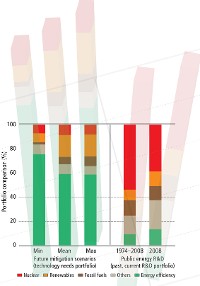Getting
the right balance in energy R&D portfolios
An assessment of future scenarios that limit the extent of global warming indicates that unless R&D investment in new, efficient, and clean energy technologies is increased, and supporting policies and market incentives are implemented, greenhouse gas (GHG) emission reduction targets are unlikely to be met, or met only at considerable cost.
The study by IIASA energy technology experts identifies energy efficiency as the single most important option for achieving significant and long-term reductions in GHG emissions, accounting for up to 50 percent of the reduction potential across the wide range of scenarios analyzed. However, investment in energy efficiency R&D has typically been less than 10 percent of the overall public sector R&D budget in the countries of the International Energy Agency (IEA). Conversely, although nuclear energy accounts for less than 10 percent of the GHG emission reduction potentials across all scenarios, it has received some 50 percent of the total public investment in energy technology R&D.
The analysis, published in the inaugural issue of the journal Carbon Management in October 2010, compared historical and current government spending on R&D by the 28 member countries of the International Energy Agency, through a “needs”-based analysis of the technologies required to achieve long-term climate stabilization. The assessment is based on the analysis of a wide range of scenarios of future technology deployment rates under a range of future uncertainties and climate constraints.
Current investments in energy technology R&D by the public sector, in all industrialized countries, show a heavy bias in favor of nuclear energy, to the detriment of energy efficiency research. Given their respective importance for future climate mitigation, this is a significant imbalance. Based on current investments, the authors estimate that a fivefold increase in investment in energy efficiency is needed to redress the balance.
According to the study the drastic emission cuts required to limit climate change will only be possible if we can achieve a major a transformation of the energy system. This will require the adoption of a range of policies and measures beyond an expanded and restructured energy technology R&D portfolio to include incentives for niche market applications and the large-scale deployment of climate-friendly technologies.
As the future is inherently uncertain, the study uses a range of scenarios—22 in total—to examine what successful or unsuccessful adoption of different technologies (such as nuclear or carbon capture and sequestration) might achieve for reducing GHG emissions. The scenarios include a “do-nothing” or “business-as-usual” scenario where, for example, R&D policies remain uncoordinated and market incentives for new technologies to minimize emissions remain unchanged. The study concludes that a business-as-usual approach to energy technology R&D will make combating climate change very difficult and more costly, reducing both the likelihood of success and the political and social acceptability of a transition to climate-friendly, energy-efficient technologies.
Based on the scenarios the authors outline a forward-looking energy R&D “portfolio” that they propose would provide the best hedging strategy to ensure that future GHG emissions can be reduced and at reasonable costs. To achieve this goal, currently unbalanced energy technology R&D portfolios need to change to reflect the respective economic values of future GHG mitigation options, which are particularly large for energy efficiency (see chart,top: Reserch & Development Imbalances. Past and current investments into developing climate-friendly technologies (R&D, right) versus future technology needs (min/mean/max across scenarios, left) by technology category).
The study, while focused on public or government-funded R&D, identifies a similar pattern of investment in the private sector, where there is a similar preference for large-scale supply-side energy technology investments to the detriment of energy efficiency.
CONTACT DETAILS
Distinguished Emeritus Research Scholar Transformative Institutional and Social Solutions Research Group - Energy, Climate, and Environment Program
Program Director and Principal Research Scholar Energy, Climate, and Environment Program
Principal Research Scholar Integrated Assessment and Climate Change Research Group - Energy, Climate, and Environment Program
Principal Research Scholar Pollution Management Research Group - Energy, Climate, and Environment Program
Principal Research Scholar Sustainable Service Systems Research Group - Energy, Climate, and Environment Program
Read this issue of Options magazine


